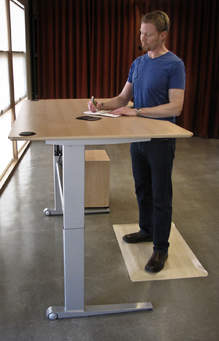Posture is the characteristic way a person holds his or her body while sitting or standing. A proper postural alignment helps one to work efficiently with minimal strain on the muscles and ligaments.
A good posture while standing requires that the weight of the body be balanced on the heels, knees slightly bent, with arms hanging freely on both sides, shoulder pulled backward , chest forward and tummy tucked in . The physical therapists define a good standing posture as alignment of the ear, shoulder, hip, knee and ankle as seen from the side. While sitting,the head should be erect and the normal curvatures of the spine, namely the cervical, thoracic and lumbar curvatures should be maintained. Keeping the shoulder squared and pulled back, head upright, with the neck back and heels well aligned, is the right way to sit.
The sitting syndrome is a term coined for people who have a over sedentary lifestyle. Sedentary lifestyle includes jobs which require long hours of sitting. Sitting for long hours itself is a risk factor for high blood pressure, increased sugar levels, abdominal obesity and increased levels of cholesterol- these are the hallmarks of the metabolic syndrome. Prolonged sitting, especially continuous sitting can cause blood flow to be sluggish and increases the risk for cardiovascular diseases. Moreover, it can dislodge a clot from the veins of the leg and result in clogging of the blood vessels of the lung and cause a fatal disease called pulmonary embolism. Sitting is the new smoking– meaning that it is as dangerous as smoking
Sitting for long periods at the office can cause low back pain, more so if the correct posture is not maintained. Over a period of time this can lead to a disc prolapse and worsening of the back pain with radiating nerve pain in the the gluts or anywhere down the the legs, as the sciatic nerve is compressed by a bulging disc. There has been an increase in the risk of ovarian and breast cancers in the sitting group of women and increased incidence of colon cancers too in both sexes.
When sitting for 8-10 hours is compulsory, then, certain interventions are necessary to avoid the health risks. Stand up desk is beneficial because it help in burning more calories and preventing obesity. These desks help in maintenance of blood sugar levels, improves low back pain, elevates mood and increases productivity. The other recommendation is that every half an hour of sitting be followed by 10 minutes of standing up and walking around. This corrects the sluggishness of the circulation and loosens up the stiffened muscles and joints and relieves the back from increased load.
Ergonomically designed chairs with back rest have been used extensively in the corporate world. These chairs have the benefit of holding the spine in the desired posture during long hours of sitting. Though these chairs help negate to a small extent the postural problems associated with prolonged sitting, it does not do away with the metabolic health hazards. Nor can the metabolic, vascular and neoplastic effects of sitting be corrected by hitting the gym after long hours of sitting. It is a proven fact that the cardiovascular hazards of long hours of sitting cannot be dealt with exercises and diet alone.
Sitting disease research has extensively studied the different interventions to minimise sitting health risks. In the IT sector, numerous steps have been taken to reduce the health hazards due to sitting too long at work. Ergonomically designed chairs with good back support are already in use. Breaks with short walks are recommended as part of the wellness drive. Reminder boards are in place with tips for prevention of the sitting disease. But when the jobs allocated are time bound and pressure to deliver is high, then the priority given to health stagnates. This is the reason for more than 90% of the sitting group developing the sitting disease.
Sometimes a reminder board is not sufficient to drive people to accept and perform the required interventions. It needs more than that. It needs personalized alarms and monitored supervised checks on the walking spells. Those employees who make this a routine in their workplace should be rewarded. One of the most rewarding intervention is the threadmill desk. It is walking while working. Hence this negates the metabolic hazards of sitting too long. The budgetary demands of these machines are minimal when compared to the mounting medical bills due to the health problems associated with prolonged sitting.

